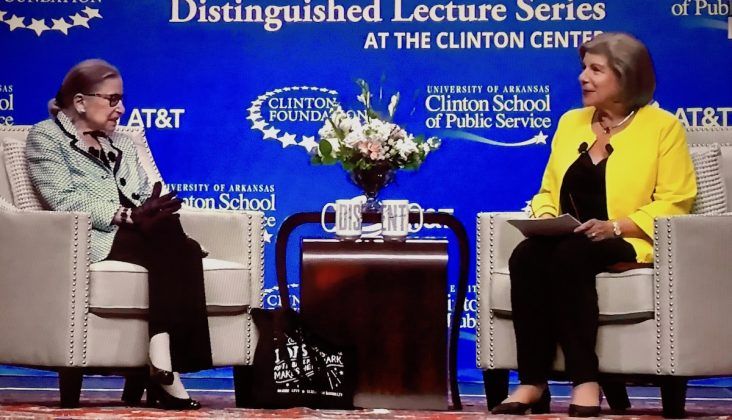Justice Ruth Bader Ginsburg recalls her historic journey on U.S. Supreme Court
by September 3, 2019 8:53 pm 1,160 views

U.S. Supreme Court Justice Ruth Bader Ginsburg (left) is interviewed by National Public Radio reporter Nina Totenberg during a Clinton School lecture series held Tuesday (Sept. 3) at Verizon Arena in North Little Rock.
U.S. Supreme Court Justice Ruth Bader Ginsburg declared herself to be “feeling very good,” described the challenges of being the Court’s second female member, and celebrated advances made by women during a question-and-answer session at North Little Rock’s Verizon Arena Tuesday (Sept. 3).
Ginsburg appeared before a capacity crowd in the arena as part of the Clinton School of Public Service’s Kumpuris Distinguished Lecture Series. The subject of two recent movies, the documentary “RBG” and a biopic, “On the Basis of Sex,” she attracted the largest crowd of any speaker in the series’ history with an estimated 13,000 in attendance. She was interviewed by National Public Radio’s Nina Totenberg after an address by former President Bill Clinton.
Ginsburg, 86, made her appearance a little more than a week after her last radiation treatment for pancreatic cancer Aug. 23 after being operated on for lung cancer late last year.
“I am pleased to say that I am feeling very good tonight,” she said.
Asked why she was in North Little Rock so soon after surgery, she said she had promised the Clinton Library that she would be there, a remark that drew a standing ovation.
Ginsburg recalled the day she was interviewed by Clinton for the prospective Supreme Court nomination. They talked about constitutional law and family. She said she was “absolutely on cloud nine” when she was nominated and easily recalled the Senate vote, 96-3, in her favor.
At the time, Justice Sandra Day O’Connor, the court’s first female member, had been serving on the court 12 years. Totenberg noted that attorneys often called O’Connor and Ginsburg by each other’s names in arguments. In response, the National Association of Women Judges gave them each a T-shirt saying that each wasn’t the other. But now that there are three women on the court, that confusion no longer occurs, Ginsburg said.
The other two are Justices Sonia Sotomayor and Elena Kagan.
Ginsburg said the period of time when she was the only woman on the court after O’Connor retired and before Sotomayor was appointed was lonely. “The public would see these eight rather well-fed men” and her, she said. There were times in conference when she would make a comment and receive no response, and then a male justice would say much the same thing, and the justices would react.
“Now that I have two sisters-in-law, it doesn’t happen,” she said.
Ginsburg struggled to find a job after graduating from law school despite ranking near the top of her class. But she and O’Connor agreed that it was a blessing to enter the profession when they did. If they had graduated at a time when there was no discrimination, they would have ended up as retired partners in a law firm rather than Supreme Court justices.
Asked by Totenberg about whether the Constitution should be interpreted as originally written or as a living document, Ginsburg noted that the Preamble begins with “We the people of the United States, in order to form a more perfect union.” At the time, those people did not include slaves, women, or men who did not own property. The original Constitution preserved the slave trade, she said. She referenced the late Justice Thurgood Marshall, the court’s first African-American justice, saying he did not celebrate the original Constitution but instead celebrated what it became as it became more inclusive.
She was asked about her friendship with the late Justice Antonin Scalia, who subscribed to an originalist viewpoint. While they had very different philosophies, they both shared a love for the Constitution, both worked hard on their opinions, and were very close friends who traveled together and shared a love of opera.
Ginsburg’s remarks were preceded by an address by former President Bill Clinton, who nominated her in 1993.
